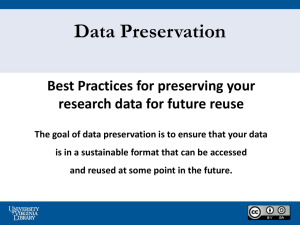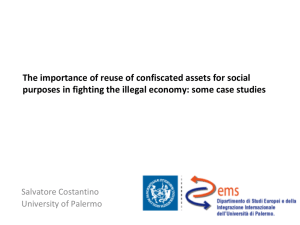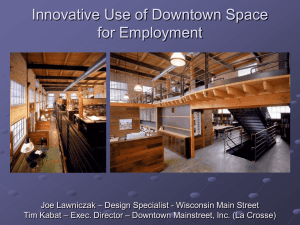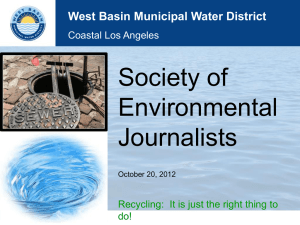PowerPoint presentation
advertisement
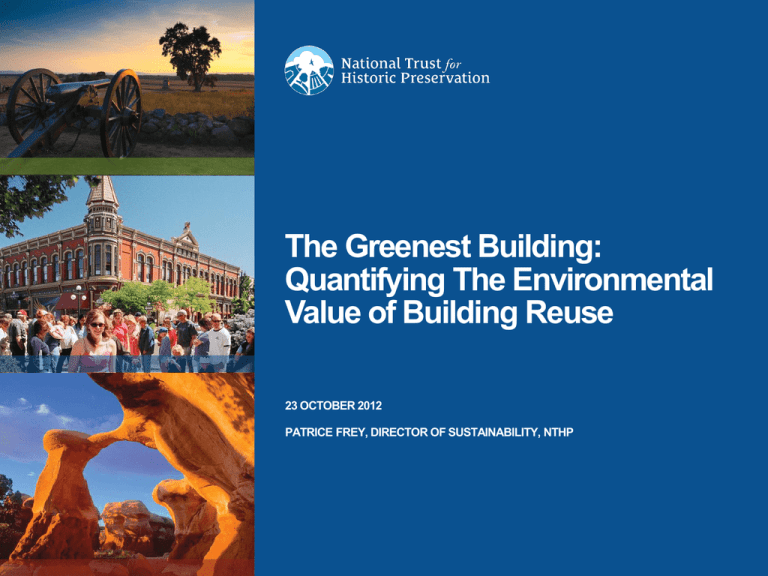
The Greenest Building: Quantifying The Environmental Value of Building Reuse 23 OCTOBER 2012 PATRICE FREY, DIRECTOR OF SUSTAINABILITY, NTHP The National Trust for Historic Preservation provides leadership, education, advocacy and resources to help people save the places that matter to them. Union Station, Washington DC Nantucket Lightship, Massachusetts © National Trust for Historic Preservation, 2012 PGL Works to… Reduce demolitions and improve building performance through research, policy development, and technical/financial tools. Wicker Park, Chicago Overview I. Building Reuse: Why does it matter? II. Understanding Demolition Trends in Chicago III. Encouraging Building Reuse I. Building Reuse: Why does it matter? U.S. Energy Use by Sector Source: U.S. Department of Energy © National Trust for Historic Preservation, 2012. Value of Old Buildings: Green Features Energy Performance of Commercial Buildings (non malls): Date Built Btu/sq. ft Before 1920 80,127 1920 – 1945 90,234 1946 – 1959 80,198 1960 – 1969 90,976 1970 – 1979 94,968 1980 – 1989 100,077 1990 – 1999 88,834 2000 – 2003 79,703 Source: U.S. Energy Information Administration, 2003 Commercial Building Energy Consumption Survey Older Buildings and Energy Use Source EUI (annual kbtu/sq ft) Median Energy Use Per Sq Ft By Building Type and Age Group Multi-family Office Year Built ®NY University/ City of New York Data Value of Old Buildings: Green Features Source: U.S. Energy Information Administration, 2005 Residential Energy Consumption Survey Beyond Building Operations: Rethinking Building Impacts from a Whole Life Cycle Perspective Buildings and Resource Use Natural Gas Distribution 3% Vehicle Bodies 2% Hospitals 2% Meat Packing 1% Fluid Milk 1% Eating & Drinking Places 3% Retail Trade 3% Maintenance 4% Petrol Refining 5% New Construction 49% Electric Services 5% Real Estate Mngmt 5% New additions & alterations 6% Owner OccupiedDwellings 11% Materials, Products and Services by Resource Use US EPA – Sustainable Materials Management: The Road Ahead (EPA June 2009) U.S. Demolition Projections 2005−2030 27% Demolished 73% Retained Source: Brookings Institution Chicago Demolitions Area Demolished 2004-2012: • 50 Million Sq Feet • Approx 1.8 Sq Miles • 530 Average City Blocks • 2,353,000 Tons of Debris Chicago, Illinois Source: Preservation Green Lab Previous Research: Residential It takes between 35−50 years for a new, green home to recover the carbon expended during the construction process. −Empty Homes Agency, UK, 2008 Previous Research: Institutional • 2006 study compared new construction vs. renovation • Approx. 38 years for new, energy efficient building to recover the carbon expended during the construction process Buchanan Building Complex, University of British Columbia. Courtesy Martin Nielsen Busby, Perkins & Will “The Greenest Building” Report Guiding Questions • Under what conditions is building reuse environmentally preferable to demolition and new construction? • Do benefits differ by region and building type? • Are there significant opportunities to reduce near term carbon emissions by reusing buildings rather than constructing anew? Case Study Buildings Single-family residential Multifamily residential Commercial Office Urban village mixed-use Elementary schools © National Trust for Historic Preservation, 2012. Lifecycle Stages © National Trust for Historic Preservation, 2012. Life Cycle Impact Assessment • Non-renewable energy • Mineral extraction Resources Ecosystem quality • Aquatic ecotoxicity • Land occupation • Terrestrial acidification & nutrification • Terrestrial ecotoxicity IMPACT2002+ Climate Change Human health • Human toxicity • Ionising radiation • Ozone layer depletion • Photochemical oxidation • Respiratory effects Climate Regions Portland (Mild Climate) Chicago (Cold Climate) Phoenix (Hot/Dry Climate) Atlanta (Hot/Humid Climate) Findings: Reuse Matters Building reuse almost always yields fewer environmental impacts than new construction when comparing buildings of similar size and functionality. © National Trust for Historic Preservation, 2012. Findings: Reuse Matters Commercial Office: Climate Change Impacts NC = New Construction RR = Reuse and Retrofit Findings: Reuse Matters Commercial Office, Portland: Climate Change Impacts Findings: Reuse Matters It can take between 10 to 80 years for a new energy efficient building to overcome, through efficient operations, the climate change impacts created by its construction. Findings: Reuse Matters The majority of building types in different climates will take between 20-30 years to compensate for the initial carbon impacts from construction. Findings: Reuse Matters A single family home will take between 38-50 years to compensate for the initial carbon impacts from construction. Project7ten - California (pending LEED Platinum); Inhabitat.com Findings: Scale Matters © National Trust for Historic Preservation, 2012. Findings: Design Matters The quantity and type of materials used in a building renovation can reduce, or even negate, the environmental benefits of reuse when compared to new construction. . Findings: Design Matters Even retrofitting an existing building has an upfront carbon impact – it typically 3-8 years to “recover” impacts. Portland Armory Building; Renovated to LEED-Platinum Image: Chris Yunker/Flickr II. Understanding Demolition Trends in Chicago Demolitions in Chicago: The Landscape 2004-2012 Demolitions of buildings: 8,714 New construction of buildings: 13,334 New construction where a demolition had occurred between 9/04 and 6/12: 2,857 Wicker Park, Chicago Demolitions in Chicago 2004-2102 North Side Building Demolition: 55% Land Area: 41% of total South Side Building Demolition: 45% Land Area: 59% of total Chicago New Construction 2004-2012 North Side building replacement rate: 51% South Side building replacement rate: 11% Demolitions in Chicago - Historic Districts 2004-2012 Only 72 demolition permits were issued within landmark districts but 1,553 demolitions occurred within a quarter mile of historic districts Demolitions in Chicago - TIF Districts 2004-2012 2,912 or 33% of all demolitions occurred within TIF districts Building Types Demolished Building Types Constructed Building Age Demolition & Population Growth Initial Findings • Significant differences between demolition patterns on the North and South sides of the city - Strong market/weak market • 33% of all demolitions are occurring within TIF districts - TIF reform to encourage reuse? • Landmark districts are doing a good job of protecting buildings - Need for better reuse incentives/protection on edge of districts Initial Findings (cont.) • Single family homes are particularly threatened • Buildings built between 1890 and 1910 appear more vulnerable to demolitions than others • Between 2004 and 2012, we don’t see demolitions accommodating greater density in areas with population growth III. Encouraging Reuse Reuse: Expanding the Planner’s Toolbox • Conventional Preservation Strategies • Landmarking/districting • Strategies for Promoting Older Building Conservation • Rightsizing parking • Conservation districts • Next-Generation Tools for Protecting Older Buildings • Energy Codes • District strategies Tipping the Scales in Favor of Reuse: The Challenges • Architects –prefer blank canvas • Industry/economy aligned behind new construction • Economics of reuse • Policy/Regulatory disincentives • Green Builders? Environmentalists? Partnership for Building Reuse • What are the market and policy barriers to reuse? • How do these vary by city/location? • What incentives are needed to increase reuse? Abandoned Building in Louisville, KY Reducing Demolitions Partnership for Building Reuse – LA Reducing Demolitions & Increasing Retrofits • Pioneering new energy code based on flexibility and measurement • Delivering retrofit solutions to smaller commercial buildings • Identifying financing sources for green retrofits Seattle Space Needle Source: Flickr Thank you! For more information…. PFrey@savingplaces.org www.preservationnation.org/greenlab @presgreenlab Receive our weekly Sustainability/Preservation news roundup: rbowdon@savingplaces.org Test Conditions © National Trust for Historic Preservation, 2012. Test Conditions Commercial Office Example: Portland Base Case Advanced Case kBTU/sf/yr 70 49 Materials Inputs RR/NC with EEMs RR/NC with additional EEMs


